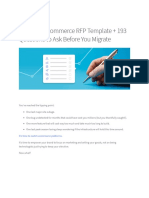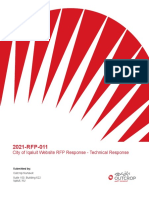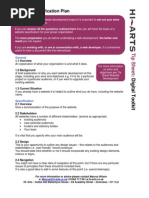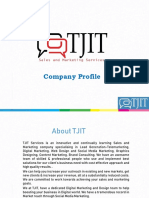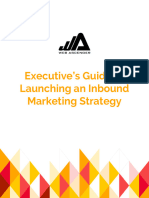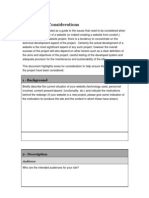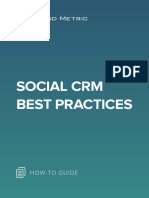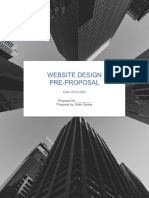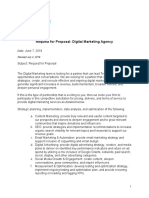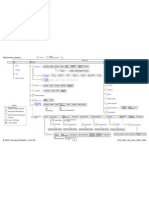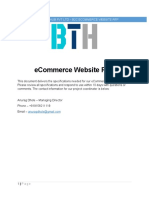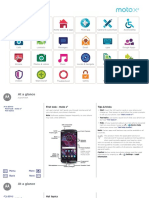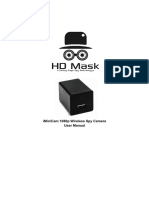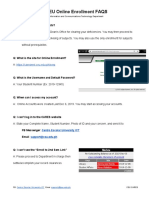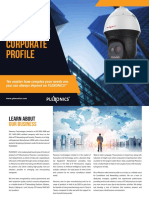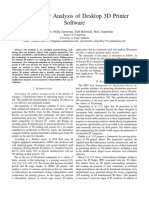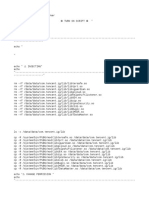Market Data / Supplier Selection / Event Presentations / User Experience Benchmarking / Best Practice / Template Files / Trends &
Innovation
Web design and build RFP
Guidance and Templates
�Web design and build RFP
Guidance and Templates
Published 2010
All rights reserved. No part of this publication may be reproduced or transmitted in any form or by any means, electronic or mechanical, including photocopy, recording or any information storage and retrieval system, without prior permission in writing from the publisher. Copyright Econsultancy.com Ltd 2010
Econsultancy London 4th Floor, 91-93 Farringdon Rd London EC1M 3LN United Kingdom Telephone: +44 (0) 20 7269 1450 http://econsultancy.com help@econsultancy.com
Econsultancy New York 41 East 11th St., 11th Floor New York, NY 10003 United States Telephone: +1 212 699 3626
�Contents
1. About Econsultancy ......................................................... 1
1.1. About This Guide.......................................................................... 1
2. Introduction to RFPs ....................................................... 2 3. Guidance notes ................................................................ 3
3.1. 3.2. Defining the overall website design process ............................... 3 Defining objectives of your website ............................................ 3
3.2.1. Current situation...................................................................... 3 3.2.2. Aims and objectives ................................................................. 4
3.3. 3.4. 3.5. 3.6. 3.7.
Defining your detailed business requirements .......................... 4 Organising the website project structure ................................... 5 Planning the Supplier Selection process .................................... 6 Using external consultants .......................................................... 7 How to use the checklist and templates ..................................... 7
4. Detailed website requirements ........................................ 8
4.1. Benchmarking ............................................................................. 8
4.1.1. Target Market .......................................................................... 8 4.1.2. Current website ........................................................................ 8 4.1.3. Competitors.............................................................................. 8
4.2.
Overall design guidelines & information .................................... 9
4.2.1. Resources and timescales ........................................................ 9 4.2.2. The organisation ...................................................................... 9 4.2.3. Product & Services ................................................................. 10
4.3. 4.4. 4.5. 4.6. 4.7. 4.8.
Design specifics: Front-end user functionality ........................ 10
4.3.1. Front-end, e-commerce user functionality ............................ 11
Design specifics: Back-end functionality ................................... 13 Build specifics: Technical requirements .................................... 15 Build specifics: Integration requirements ................................. 15 Design specifics: Reporting requirements ................................ 17 Design specifics: Future requirements ...................................... 17
5. Templates: Project summary ......................................... 18
5.1. 5.2. 5.3. About the organisation ...............................................................18 About the website project ..........................................................18 Supplier selection process ..........................................................19
1
Web design and build RFP Guidance and Templates
All rights reserved. No part of this publication may be reproduced or transmitted in any form or by any means, electronic or mechanical, including photocopy, recording or any information storage and retrieval system, without prior permission in writing from the publisher. Copyright Econsultancy.com Ltd 2010
�6. Templates: Specific requirements ................................. 20
6.1. 6.2. Design Guidelines ..................................................................... 20 Build Guidelines ......................................................................... 21
7. Templates: Supplier information .................................. 22
7.1. 7.2. 7.3. Supplier background ................................................................. 22 Support provision ...................................................................... 22 Supplier proposal ...................................................................... 23
Web design and build RFP Guidance and Templates
All rights reserved. No part of this publication may be reproduced or transmitted in any form or by any means, electronic or mechanical, including photocopy, recording or any information storage and retrieval system, without prior permission in writing from the publisher. Copyright Econsultancy.com Ltd 2010
�1.
About Econsultancy
Econsultancys reports, events, online resources and training help an international community of more than 85,000 digital marketers make better decisions, build business cases, find the best suppliers, look smart in meetings and accelerate their careers. Econsultancy, which has offices in London and New York, is an award-winning online publisher of reports covering best practice, user experience benchmarking, market data, trends and innovation, and supplier selection. Econsultancy also operates a highly popular training division, used by some of the worlds most prominent brands for staff education, both in-house and via public courses. Econsultancy provides training across all areas of digital marketing and at all levels from one-day courses to an MSc in Digital Marketing. In addition, Econsultancy hosts more than 100 conferences and events a year, including the annual Future of Digital Marketing conference, the Peer Summit, Roundtables, Briefings and a range of social events. Econsultancy also runs the Innovation Awards where pioneering work in the world of digital marketing and e-commerce is judged by an international panel of experts. The Econsultancy.com site attracts 175,000 unique users per month who access research, read the blog and take part in discussions in the forums. Econsultancy members can also link up with other members and digital suppliers through the directories, as well as find a new job or new digital talent using the job listings. Some of Econsultancys members include: Google, Yahoo, Dell, BBC, BT, Shell, Vodafone, Yell.com, Oxfam, Virgin Atlantic, Barclays, Carphone Warehouse, IPC Media, Deloitte, T-Mobile and Este Lauder. Join Econsultancy today to learn whats happening in digital marketing and what works. Call us to find out more on +44 (0)20 7269 1450 (London) or +1 212 699 3626 (New York). You can also contact us online.
1.1.
About This Guide
This document is an RFP guideline and outlines the section headings and some of the factors to consider, in the form of a template. Text is often for your consideration of how to structure the content of your questions and should always be replaced with your own text. If you would like to know more about corporate membership and our roundtables or events then please contact us on +44 207 681 4053 or Peter.Abraham@Econsultancy.com. If you have any comments or queries about this briefing then please contact Econsultancys Research Director; Linus.Gregoriadis@Econsultancy.com http://Econsultancy.com
Web design and build RFP Guidance and Templates
All rights reserved. No part of this publication may be reproduced or transmitted in any form or by any means, electronic or mechanical, including photocopy, recording or any information storage and retrieval system, without prior permission in writing from the publisher. Copyright Econsultancy.com Ltd 2010
�2.
Introduction to RFPs
An RFP (Request For Proposal) is a document outlining the background to your objectives and a detailed list of business requirements for a given project. Typically, an RFP is sent to your likely group of suppliers/partners in order to solicit their proposals to work with you. RFPs can be extremely valuable in optimising the chances that suppliers deliver the solutions that you need, encouraging the following: Internal agreement: allow you to discuss and finalise your requirements with all of the internal (and agency) stakeholders before involving a further supplier. Accurate proposals: allow suppliers to clearly understand your needs so they can provide you with the most accurate estimates of their best solution. Comparable solutions: ensure that each supplier receives the same set of requirements and therefore replies with a similar and comparable set of proposed solutions.
The purpose of this document is to outline some of the most important elements that might need to be considered by a Client Company when putting together a Request For Proposal from an Affiliate Marketing Company. The factors considered here are by no means exhaustive, but equally, depending on circumstances, not all of these will always need to be considered. Consider this document to be a starting point from which you can pick and mix elements to include in your RFP. Different Types of RFPs: Although you may see these terms used interchangeably, they are decidedly different documents. Consider where you are in your process and what you want to achieve out of the exercise and then start by being accurate about what sort of document you are asking your potential suppliers to answer: RFI (Request for Information) This document can simply be a fact sheet, often being used for initial planning purposes. In the case of small projects, this document can be used for decision making as well.
Web design and build RFP Guidance and Templates
All rights reserved. No part of this publication may be reproduced or transmitted in any form or by any means, electronic or mechanical, including photocopy, recording or any information storage and retrieval system, without prior permission in writing from the publisher. Copyright Econsultancy.com Ltd 2010
�3.
3.1.
Guidance notes
Defining the overall website design process
You will need to define the expected overall expectations and processes of your website. This involves identifying the key applications and resources you will need, along with indicating desired styles, colour and design. You also need to indicate what you:
3.2.
Defining objectives of your website
Before you begin the RFP process, its helpful to define the scope of what information you want your website to contain, what you are hoping to achieve by creating it and how you expect users to engage with it. This will help you to define your business requirements and plan the supplier selection process. You should consider the following...
3.2.1.
Current situation
Do you currently have a live site? What are your current traffic volumes? Which countries do you mainly want to deliver website content to?
3.3.
Defining your detailed business requirements
It is helpful if you define the requirements for your new website as early in the project as possible and in as much detail as you can. These requirements should cover every aspect of the operation, not just the elements you plan to outsource. This can be a time-consuming process, but the more thinking you do and the more clarity you can provide at this stage, the easier it will be to develop the resources you need within your business, define your internal processes and select the third-party service providers who are best-placed to meet your needs.
3.4.
Organising the website project structure
Ideally, the people who are going to be involved in your web design project should be brought together at the earliest possible opportunity, so that each can provide their input into the early planning and decisions that are made. Involvement from across the business in the requirements definition phase is particularly helpful. A typical project structure is as follows: Project Sponsor The Project Sponsor is person who is ultimately responsible for the delivery of the project; they generally occupy a very senior role within the business and are usually a member of the Leadership Team.
Web design and build RFP Guidance and Templates
All rights reserved. No part of this publication may be reproduced or transmitted in any form or by any means, electronic or mechanical, including photocopy, recording or any information storage and retrieval system, without prior permission in writing from the publisher. Copyright Econsultancy.com Ltd 2010
�3.5.
Planning the Supplier Selection process
The approach you take to your service supplier selection process will be dictated by the scale of your project, the number of third-party service providers you plan to use and whether you need external support to help you complete the process. Ideally the Project Manager should lead the supplier selection process from outset and the Project Team, Steering Group and Project Sponsor should sign-off the business requirements and the RFQ documents you plan to use. This will ensure that there is a solid understanding of what the business is trying to achieve throughout the project.
3.6.
Using external consultants
Documenting detailed business requirements and preparing for and managing an RFP process can be a complex and time-consuming business and getting it right is critical to achieving the ambitions you have for your website. This is especially true when organisations have to outsourcing several aspects of their design process at the same time.
3.7.
How to use the checklist and templates
The checklist in Section 4 should help you think through your detailed business requirements, as they provide a set of questions that normally need to be defined for any potential supplier during the definition process of your needs in a website design and build RFP. Sections 5-6 provide various templates for presenting potential service providers with information about your business and your web project. It has been prepared with design and build in mind, but could be easily adapted for other services you are planning to outsource, such as content management systems. Section 7 provides simple templates for you to summarise those aspects of your detailed business requirements on which you wish candidates to respond.
4.
Detailed website requirements
The following checklist will help you define the detailed requirements you are expecting your website to have. It is not exhaustive, but the structure and approach should help you identify the elements that are important to your organisation
4.1 Benchmarking
4.1.1 Target Market
Who is the main demographic for your services and products? Who influences buying? Who will actually be using your products and services?
4.1.2
Current website
Do you have a current (live) website or an existing online presence upon which the new site should be based? What is the URL or location of this?
Web design and build RFP Guidance and Templates
All rights reserved. No part of this publication may be reproduced or transmitted in any form or by any means, electronic or mechanical, including photocopy, recording or any information storage and retrieval system, without prior permission in writing from the publisher. Copyright Econsultancy.com Ltd 2010
�4.3
Design specifics: Front-end user functionality
The user proposition What kind of content will be online? How frequently will it be updated? Site sections What specific site sections are needed? Does this content currently exist and, if not, how will it be created?
3.7.1.
Front-end, e-commerce user functionality
Navigation How do you want your range to be structured (section & sub-section names)? Do you want persistent or context sensitive navigation? Do you want fixed or dynamic visibility of the menu structures?
3.8.
Design specifics: Back-end functionality
General Content Management Do you have any specific requirements for other existing or expected areas of content on your site? How do you want to be able to handle promotional images and minor layout changes? Analytics Who in your organisation will be responsible for monitoring and reacting to your sites key performance metrics, such as visitor traffic analysis, campaign analysis, funnel analysis and sales conversion? How would you like them to access this information and how will it be combined with the other reporting processes you use in your business?
3.9.
Build specifics: Technical requirements
Data security/access Do you have any corporate requirements for data security, data access or data formatting? What are your requirements for site uptime, access and download speeds?
Web design and build RFP Guidance and Templates
All rights reserved. No part of this publication may be reproduced or transmitted in any form or by any means, electronic or mechanical, including photocopy, recording or any information storage and retrieval system, without prior permission in writing from the publisher. Copyright Econsultancy.com Ltd 2010
